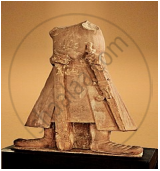Advertisements
Advertisements
प्रश्न
Write a short essay (about 500 words) on the following:
Discuss the notions of kingship that developed in the post-Mauryan period.
उत्तर
In the post-Mauryan age, the idea of kingship got associated with divine theory of state. Now, the monarchs began to talk about divine sanction to rule the people. Kushan rulers propagated the idea of the same at the unprecented scale. They ruled from central Asia to western India. We can discuss the kingship based on the dynasties.
1.Kushan Kings: Kushan Kings called themselves Devputra and hence, godly status. They built great statues of themselves in temples.
2.Gupta Rulers: Second development of kingship is found during Gupta dynasty. It was a period of large-sized states. Such states were dependent on Samantas who sometimes became powerful enough to usurp the power of kings too.
3.Literature, coins and inscriptions helped us in creating history of those days. Very often poets would describe the monarch often to praise them but giving insight into the history and kingship too. A good example is of Harisena who praised Samudragupta, the great Gupta ruler.
APPEARS IN
संबंधित प्रश्न
Answer in 100-150 words
Compare and contrast the list of things given to the Pandyan chief (Source 3) with those produced in the village of Danguna (source 8). Do you notice any similarities and differences?
Source 3 :- (The Pandya chief Senguttuvan visits the forest)
This is an excerpt from the Silappadikaram, an epic written in Tamil:-
(When he visited the forest) people came down the mountain, singing and dancing ... just as the defeated show respect to the victorious king, so did they bring gifts – ivory, fragrant wood, fans made of the hair of deer, honey, sandalwood, red ochre,
antimony, turmeric, cardamom, pepper, etc. ... they brought coconuts, mangoes, medicinal plants, fruits, onions, sugarcane, flowers, areca nut, bananas, baby tigers, lions, elephants, monkeys, bear, deer, musk deer, fox, peacocks, musk cat, wild cocks, speaking parrots, etc. ...
Source 8 :- (Prabhavati Gupta and the village of Danguna)
This is what Prabhavati Gupta states in her inscription:- Prabhavati Gupta … commands the gramakutumbinas (householders/peasants living in the village), Brahmanas and others living in the village of Danguna ...
“Be it known to you that on the twelfth (lunar day) of the bright (fortnight) of Karttika, we have, in order to increase our religious merit donated this village with the pouring out of water, to the Acharya (teacher) Chanalasvamin … You should obey all (his) commands ...
We confer on (him) the following exemptions typical of an agrahara …(this village is) not to be entered by soldiers and policemen; (it is) exempt from (the obligation to provide) grass, (animal) hides as seats, and charcoal (to touring royal officers); exempt from (the royal prerogative of) purchasing fermenting liquors and digging (salt); exempt from (the right to) mines and khadira trees; exempt from (the obligation to supply) flowers and milk; (it is donated) together with (the right to) hidden treasures and deposits (and) together with major and minor taxes ...”
This charter has been written in the thirteenth (regnal) year. (It has been) engraved by Chakradasa.
Who composed the Prayag Prashasti in praise of Samudragupta?
Sangam is literature of ____________ language.
Harishena was the court poet of ____________.
Who among the following was the composer of ‘Prayaga Prashasti’?
Two statements are given in the question below as Assertion (A) and Reasoning (R).
Assertion (A): From c. 500 BCE norms were compiled in Sanskrit texts known as the Dharmasutras and Dharmashastras.
Reason (R): Brahmanas laid the codes of social behaviour for the society in general.
Match the following.
| List I | List II |
| A. Allahabad | 1. Commercial and political capital under Kushanas |
| B. Mathura | 2. Capital of Magadha |
| C. Puhar | 3. Samudragupta pillar inscription |
| D. Rajagaha | 4. Coastal town in South India |
Identify the given image from the following options.

In which of the following regions Satvahanas rules during second century BCE to Second century CE?
